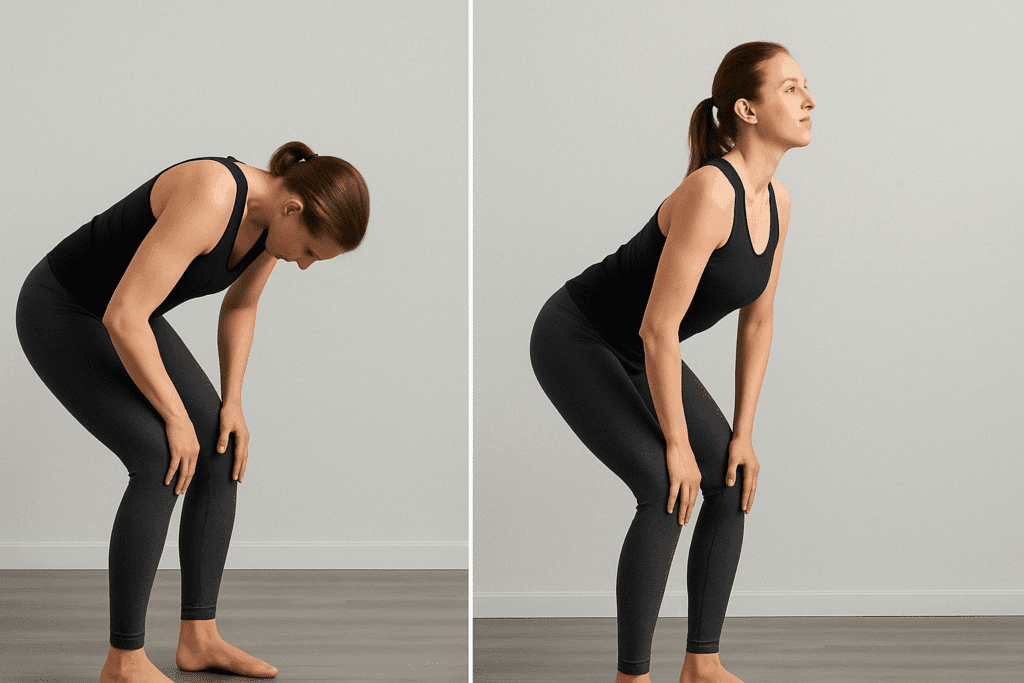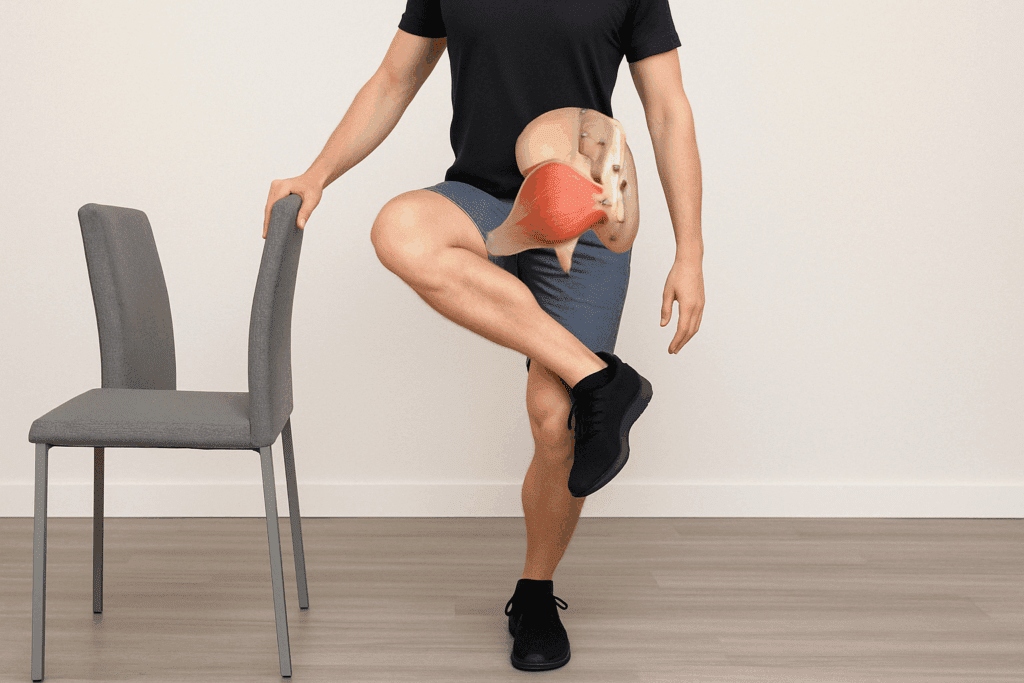Lower back pain is one of the most common physical ailments, affecting people across all age groups and lifestyles. Whether you’re a desk worker sitting for extended periods, an athlete pushing your physical limits, or simply experiencing the wear and tear of daily life, discomfort in the lumbar region can seriously impact your quality of life. Fortunately, stretching can play a crucial role in alleviating this pain—especially when done consistently and with proper form. In this comprehensive guide, we explore 13 stretches for lower back pain standing, offering effective, science-backed solutions to support spinal health, improve flexibility, and help you move more comfortably throughout your day.
You may also like : Best Stretches for Sore Legs and Tight Thigh Muscles: How to Relieve Upper Leg Pain Safely and Naturally
Standing stretches are particularly valuable because they can be performed almost anywhere—at home, in the office, or even outside—and they don’t require a mat or special equipment. By targeting specific muscle groups connected to the lower back, including the hamstrings, hip flexors, glutes, and erector spinae, these movements promote alignment, reduce muscular tension, and increase circulation. The result? A noticeable reduction in pain and stiffness, along with better posture and mobility.
Let’s explore each of the 13 stretches for lower back pain standing, along with expert guidance on how and why they work. By incorporating these movements into your daily routine, you may experience significant relief, as well as preventative benefits for long-term spinal health.

The Benefits of Standing Stretches for Lower Back Pain
Before diving into the specific movements, it’s important to understand why standing stretches are so effective. Unlike passive or supine stretches, standing stretches engage the core and stabilizing muscles, which are essential for maintaining balance and posture. This engagement activates neuromuscular pathways that support spinal integrity and overall coordination. It also ensures that the muscles surrounding the lower back remain active during the stretch, which prevents over-relaxation and maintains healthy muscle tone.
Another advantage of standing stretches is that they mimic everyday movements. Functional stretching—i.e., movements that replicate daily activity—can help condition the body to perform those actions with greater efficiency and less discomfort. This makes the 13 stretches for lower back pain standing especially relevant for individuals looking to improve their quality of life outside the gym or yoga studio. For example, bending to pick up a bag, reaching to grab something off a shelf, or simply standing for long periods can all benefit from enhanced flexibility and muscle control.
Moreover, standing stretches promote better blood flow to the lumbar spine and surrounding muscles. This is essential because oxygen and nutrients delivered through circulation help reduce inflammation, speed up recovery, and enhance tissue resilience. Many healthcare providers now recommend movement-based interventions as a first-line treatment for chronic lower back pain, and incorporating targeted stretching can be a gentle, non-invasive way to start.
Forward Fold with Knee Bend
This foundational stretch targets the hamstrings, lower back, and calves. Unlike the traditional straight-legged forward fold, bending the knees slightly relieves pressure on the lower back while still allowing for an effective stretch.
Begin by standing with your feet hip-width apart. Slowly hinge at your hips, not your waist, and fold your torso forward toward the ground. Let your arms dangle, or gently clasp your elbows and sway side to side. Keep your knees bent to a comfortable degree, especially if you have tight hamstrings or lower back sensitivity. As you hold the pose for 30–60 seconds, you should feel a lengthening in your lower spine and the back of your legs.
This stretch is especially effective for decompressing the spine after prolonged sitting or standing. The bend in the knees takes the strain off the lumbar vertebrae, making it safer for people with disc issues or chronic lower back tension. It’s also a meditative movement that helps release built-up tension in both the mind and body.
The Role of Pelvic Alignment and Core Activation
The pelvis serves as a keystone structure between the upper and lower body. Anterior pelvic tilt, a condition in which the front of the pelvis tilts downward, is commonly associated with tight hip flexors and weak glutes or abdominals. This postural distortion increases lordotic curvature (the inward curve) of the lumbar spine, which can result in chronic lower back strain.
Standing stretches alone may not fully correct pelvic misalignment, but they are an essential component when paired with core strengthening and postural training. The standing hip flexor stretch, for instance, can be greatly enhanced by engaging the lower abdominals and glutes during the movement. This active contraction creates a reciprocal inhibition effect—whereby one muscle group relaxes as the opposing group contracts—leading to more effective and lasting muscle lengthening.
It’s also important to emphasize core stability over simply aiming for flexibility. The transverse abdominis and multifidus muscles, which provide deep core support, are often underactive in people with chronic back pain. Incorporating balance-challenging elements into your standing stretches—such as closing your eyes or standing on one foot—can activate these stabilizers and improve proprioception, which is the body’s ability to sense its position in space.

Standing Cat-Cow Stretch
Adapted from the popular yoga pose, this dynamic stretch alternates spinal flexion and extension, helping to lubricate the joints and mobilize the entire back chain.
Start by placing your hands on your thighs or knees, feet shoulder-width apart. On an inhale, arch your back slightly, lifting your chest and tilting your pelvis forward—this is your “cow” pose. On the exhale, round your spine, tucking your chin and pelvis to form the “cat” pose. Move slowly and repeat this sequence for 5–10 cycles.
This motion not only eases lower back tension but also strengthens the surrounding musculature. It promotes spinal articulation, increases circulation to the discs, and helps reinforce the mind-body connection. Because it involves both flexion and extension, it’s ideal for warming up or cooling down during your daily routine.
Standing Lateral Side Stretch
This stretch targets the obliques and quadratus lumborum, two muscle groups often overlooked but essential in stabilizing the lower back.
Stand tall with your feet hip-width apart and arms extended overhead. Clasp your left wrist with your right hand, inhale, and stretch to the right side, feeling a deep elongation through your left flank. Hold for 30 seconds, then switch sides.
Many people focus only on forward and backward motions when addressing lower back pain, neglecting the lateral plane. However, incorporating side stretches helps release tension that accumulates from asymmetrical movements like carrying a bag on one side or twisting awkwardly. This movement also improves flexibility in the rib cage, which can contribute to more efficient breathing and reduced upper back strain.

Standing Hip Flexor Stretch
Tight hip flexors can tilt the pelvis forward, placing undue stress on the lumbar spine. Stretching these muscles helps restore alignment and reduce back pain.
Stand in a split stance with your right foot forward and left foot back, about two feet apart. Slightly bend your front knee while keeping your back leg straight. Tuck your pelvis under and lean forward slightly until you feel a stretch in the front of your left hip. Hold for 30 seconds, then switch sides.
This position mimics a lunge but without lowering to the floor, making it accessible for people with knee or balance issues. By lengthening the iliopsoas and rectus femoris muscles, this stretch can alleviate compensatory tension in the lower back and improve overall posture. For added benefit, engage your glutes during the stretch to deepen the release.

Standing Glute Stretch (Figure Four)
The glutes, particularly the piriformis muscle, play a pivotal role in lower back stability. Tightness here can lead to imbalances and sciatic-like symptoms.
Begin standing near a wall or chair for support. Cross your right ankle over your left thigh, just above the knee. Slowly bend your left leg and lower into a semi-squat, forming a “figure four” shape with your legs. Keep your chest lifted and hold for 30 seconds before switching sides.
This stretch can be transformative for individuals who sit for long periods, as it counteracts compression in the hips and lower spine. It also builds balance and proprioception, which are essential for fall prevention and spinal coordination. Because it’s weight-bearing, it provides gentle strengthening along with flexibility.
Standing Hamstring Stretch
Tight hamstrings are a major contributor to lower back strain, particularly in people with sedentary lifestyles or limited flexibility.
Stand with your feet hip-width apart and place one heel on an elevated surface like a stair or low bench. Keep your spine straight and hinge at the hips to lean forward, maintaining a neutral back. Avoid rounding your spine and focus on feeling the stretch in the back of your thigh. Hold for 30 seconds, then repeat on the opposite side.
Regularly incorporating this stretch into your routine can gradually increase hamstring flexibility, which reduces the need for compensatory movements in the lumbar region. A mobile hamstring also allows for a more upright posture during walking and sitting, alleviating cumulative stress on the back.
Standing Spinal Twist
Twisting movements help mobilize the thoracic and lumbar spine while activating core stabilizers.
Stand with your feet shoulder-width apart and gently rotate your torso to the right, placing your left hand on your outer right thigh for leverage. Keep your hips facing forward and twist only through the upper body. Hold for 20–30 seconds, then switch sides.
This stretch enhances spinal rotation and relieves tension from prolonged sitting or asymmetrical activities. It also improves digestion by stimulating internal organs, making it a great stretch to include post-meal or after long hours at your desk.
Standing Calf Stretch with Forward Lean
Though often overlooked, the calves are connected to lower back health through the posterior chain.
Stand facing a wall, with one foot forward and one foot back. Press your back heel into the ground as you lean forward into the wall. Keep your back leg straight and feel the stretch in your calf. Hold for 30 seconds on each side.
Tight calves can subtly alter your gait, which may cause cascading misalignments up the kinetic chain, affecting the hips and lower back. Loosening this area contributes to overall biomechanical efficiency and reduces strain during walking, running, and standing.
Wall-Assisted Standing Backbend
This gentle backbend counteracts forward flexion and opens up the front body while decompressing the lower spine.
Stand a few inches away from a wall with your back facing it. Place your hands on your lower back for support and slowly lean backward, letting the wall catch you. Only go as far as is comfortable, and focus on lifting through the chest rather than crunching the lower back.
This movement is particularly helpful for people who spend hours hunched over computers or devices. It encourages thoracic extension, opens the hip flexors, and provides relief from the compressive forces that contribute to lower back pain.

Breathing Techniques for Enhanced Stretching and Pain Management
The diaphragm is not only the primary muscle of respiration but also plays a key role in spinal stabilization. Diaphragmatic or belly breathing supports intra-abdominal pressure, which in turn helps stabilize the spine during movement. Unfortunately, many people adopt shallow chest breathing, especially during moments of pain or stress.
When performing the 13 stretches for lower back pain standing, integrating slow, deep breathing can significantly enhance their effects. Inhale through your nose, allowing your belly to expand, and exhale slowly through your mouth, encouraging the parasympathetic nervous system to activate. This signals the body to relax and may reduce the perception of pain by altering nervous system sensitivity.
One advanced technique is to use breath to deepen each stretch. As you inhale, find length in your posture. As you exhale, gently move further into the stretch without forcing it. This rhythmic approach not only deepens the stretch but also makes the experience more meditative and calming.

Stretch Duration, Frequency, and Progression Principles
There is ongoing debate in exercise science regarding how long a stretch should be held. While traditional advice recommends 15–30 seconds, newer research suggests that holds of up to 60 seconds may provide greater improvements in flexibility and tissue remodeling. For chronic tightness or fascial release, even longer passive holds—up to two minutes—can be beneficial when done safely.
However, duration alone is not enough. Stretching must be progressive. As your flexibility improves, explore deeper angles, increased ranges of motion, or more advanced variations. For instance, the basic standing glute stretch (figure four) can evolve into a deeper seated version using a bench for support, or be performed on an unstable surface like a balance pad to increase neuromuscular demand.
Frequency also matters. To maintain flexibility and spinal health, aim for at least five days per week of stretching, even if only for 10–15 minutes. On particularly tight days, consider two shorter sessions—morning and evening—to optimize tissue hydration and elasticity.
Stretching as a Tool in Multimodal Pain Management
While stretching offers many benefits, it is most effective when integrated into a multimodal strategy. This may include manual therapy (such as massage or chiropractic care), physical therapy exercises, strength training, and ergonomic adjustments in your work or home environment. If you work at a desk, ensure that your screen is at eye level, your chair supports your lower back, and that you take movement breaks at least once an hour.
Complementary therapies such as acupuncture, dry needling, and heat/cold therapy may also support your stretching efforts by reducing pain sensitivity and promoting tissue recovery. If you have persistent or worsening back pain, consult a healthcare professional before attempting advanced stretches.
Tailoring Standing Stretches for Special Populations
Not all standing stretches are appropriate for every individual. Pregnant women, for example, may need to avoid deep forward bends or positions that compress the abdomen. Seniors with balance issues might benefit from holding onto a chair or wall during single-leg stretches. People with spinal stenosis or herniated discs may need to limit extension-based stretches and prioritize flexion-based ones instead.
If you fall into one of these groups, consult with a healthcare provider before beginning a new stretching regimen. You may also consider using props like resistance bands, yoga blocks, or wall support to modify each stretch safely.
Standing Quadriceps Stretch
The quadriceps, particularly the rectus femoris, can become overly tight and tug on the pelvis, exacerbating lower back discomfort.
Stand on one leg while holding your opposite ankle behind you, bringing your heel toward your buttocks. Keep your knees close together and your pelvis tucked slightly to avoid overarching the back. Hold for 30 seconds, then switch sides.
This stretch improves hip extension and encourages a more neutral pelvic position, reducing lumbar lordosis (excessive curve in the lower back). It also improves mobility in walking and climbing stairs.
Standing IT Band Stretch
The iliotibial (IT) band runs along the outside of the thigh and can impact the lower back by affecting hip alignment.
Cross your right leg behind your left and reach your right arm overhead, leaning to the left. Hold this side stretch for 30 seconds, feeling the pull along the outside of your thigh and flank. Repeat on the opposite side.
This stretch supports lateral stability and can be especially helpful for runners or individuals with tight hips. By releasing tension along the side body, it contributes to better spinal alignment and decreased back strain.
Standing Doorframe Chest Opener
Though not directly targeting the lower back, this stretch releases tension in the chest and shoulders that often causes compensatory lumbar extension.
Stand in a doorway and place your forearms on each side of the frame, elbows at shoulder height. Gently step forward until you feel a stretch across the chest. Hold for 30 seconds.
Opening the chest improves postural balance by encouraging scapular retraction and reducing the tendency to arch the lower back. This indirect benefit is crucial for comprehensive lower back relief.
Frequently Asked Questions: Advanced Insights on Standing Stretches for Lower Back Pain Relief
1. Can standing stretches benefit people with long-term lower back conditions like disc herniation or spinal stenosis?
Yes, but with careful adaptation. Individuals with long-standing spinal issues such as disc herniation or spinal stenosis should modify standing stretches to avoid exacerbating symptoms. For instance, some of the 13 stretches for lower back pain standing may need to be performed with less spinal extension or on a wall for support. Consulting a physical therapist to customize your approach is key. That said, gentle standing movements can often improve circulation, reduce nerve irritation, and enhance mobility when done correctly. When used as part of a supervised rehabilitation program, the 13 stretches for lower back pain can be safe and beneficial.
2. How do standing stretches compare to floor-based stretches in terms of spinal decompression?
Floor-based stretches are often better at passively decompressing the spine, especially in supine positions where gravity is less compressive. However, the 13 stretches for lower back pain standing activate the core and stabilizer muscles, creating a functional decompression effect. They simulate real-life postures and movements, helping your spine adapt to daily tasks. While they may not produce the same level of passive release as lying stretches, they offer long-term support by enhancing posture and core integrity. For best results, combine both approaches for a well-rounded spinal care routine.
3. What’s the best time of day to perform these standing stretches for maximum benefit?
There is no universally ideal time, but different timing strategies can target specific benefits. Doing the 13 stretches for lower back pain standing in the morning helps loosen stiffness from sleep and improves circulation. Evening sessions, on the other hand, are great for unwinding accumulated tension and preparing your body for restful sleep. You may also find midday breaks beneficial if your job involves long hours of sitting or standing. What matters most is consistency, so choose a time that you can integrate into your daily routine without fail.
4. Can these standing stretches help correct muscular imbalances contributing to lower back pain?
Absolutely. Many cases of lower back pain stem from imbalances between hip flexors and extensors, or between dominant and underused sides of the body. The 13 stretches for lower back pain standing can be customized to emphasize one side more than the other, targeting asymmetry directly. For instance, holding a glute stretch longer on your tighter side can begin to reestablish balance. Over time, consistent attention to both flexibility and alignment helps restore muscular harmony, reducing the compensations that often stress the lower spine.
5. How do footwear and surface choice impact the effectiveness of standing stretches?
Surprisingly, your footwear and the surface beneath you can significantly affect your alignment and stability during these stretches. Performing the 13 stretches for lower back pain standing on a soft surface, like a yoga mat on carpet, may reduce feedback from the ground, decreasing balance and proprioception. Barefoot stretching on a firm floor often allows for better control and foot muscle activation. If you wear shoes, opt for ones with flat soles that do not tilt your pelvis forward. Your setup matters—a stable environment enhances the effectiveness of each movement.
6. Are there psychological or emotional benefits to incorporating standing stretches into a daily routine?
Yes, and these are often overlooked. The 13 stretches for lower back pain standing can serve as a moving meditation, helping calm the nervous system, reduce cortisol levels, and interrupt negative postural habits tied to stress. Gentle stretching stimulates the vagus nerve, which plays a key role in emotional regulation and relaxation. Over time, these practices can promote greater emotional resilience alongside physical relief. Many people report feeling mentally clearer and more grounded after engaging in a short stretching session.
7. Can these stretches be safely performed by older adults or individuals with limited mobility?
Most of the 13 stretches for lower back pain standing can be modified for seniors or those with mobility limitations. For example, using a chair, wall, or countertop for balance can make forward folds or hip flexor stretches more accessible. Gentle movement within a comfortable range is still valuable for stimulating circulation and maintaining flexibility. It’s important, however, to avoid any stretch that causes pain or dizziness. When introduced gradually and mindfully, these standing stretches can be safe and highly beneficial for older populations.
8. How can breathwork enhance the effects of these standing stretches for lower back pain?
Incorporating intentional breathwork can amplify the neuromuscular benefits of the 13 stretches for lower back pain standing. Slow, diaphragmatic breathing helps release muscular tension and improves oxygen delivery to tight or inflamed tissues. Coordinating breath with movement—for example, inhaling to prepare and exhaling to deepen into a stretch—can increase range of motion and reduce resistance. Breath also serves as an anchor for mindfulness, making your stretch session more focused and therapeutic. Over time, your nervous system learns to associate these movements with calm and comfort.
9. Are there specific populations who should avoid certain standing stretches?
Yes, not all stretches are suitable for everyone. People with balance disorders, vertigo, or recent orthopedic surgeries may need to avoid or significantly adapt some of the 13 stretches for lower back pain standing. Pregnant individuals should skip deep forward folds and certain twists due to changes in pelvic stability and center of gravity. Those with high blood pressure should avoid positions that involve head-below-heart orientation for extended periods. It’s always best to consult a healthcare professional before beginning any new stretching regimen, especially if you have complex medical conditions.
10. How can I track progress when using standing stretches to manage lower back pain?
Tracking progress goes beyond pain levels. Consider documenting improvements in flexibility, posture, balance, and range of motion over time. Taking weekly photos of your stretch form, noting ease of movement, or using apps that monitor body alignment can be insightful. The 13 stretches for lower back pain standing also offer a chance to measure your resilience to daily tasks—less soreness after gardening or fewer twinges after lifting groceries, for example. By setting both subjective and objective markers, you’ll gain a clearer sense of how these stretches contribute to your overall spinal wellness.
Conclusion: Making Standing Stretches a Lifelong Habit for Spinal Wellness
Integrating the 13 stretches for lower back pain standing into your routine offers a highly accessible, equipment-free strategy to reduce discomfort, improve flexibility, and support long-term spinal health. These stretches not only target the lower back directly, but also address surrounding areas that contribute to lumbar tension, such as the hips, hamstrings, glutes, and even the shoulders. By activating the core stabilizers and enhancing posture, standing stretches create a foundation for more pain-free, fluid movement in everyday life.
Consistency is key. While a single stretching session can provide temporary relief, it’s the ongoing practice that delivers lasting benefits. Start by incorporating a few of these stretches into your morning or evening routine, and gradually build up to a full sequence. The more often you perform them, the more your body adapts—becoming more mobile, resilient, and aligned over time.
Ultimately, these 13 stretches for lower back pain standing empower you with practical tools to manage pain and restore physical balance. They are more than just movements—they are a commitment to self-care, functional fitness, and lifelong spinal wellness. Whether you’re seeking immediate relief or building a preventive strategy for the future, standing stretches offer a safe, scientifically supported path forward. Embrace them as a daily ritual and experience the transformative impact they can have on your body and your life.
Was this article helpful? Don’t let it stop with you. Share it right now with someone who needs to see it—whether it’s a friend, a colleague, or your whole network. And if staying ahead on this topic matters to you, subscribe to this publication for the most up-to-date information. You’ll get the latest insights delivered straight to you—no searching, no missing out.
Further Reading:
Best stretches for lower back flexibility and pain relief


